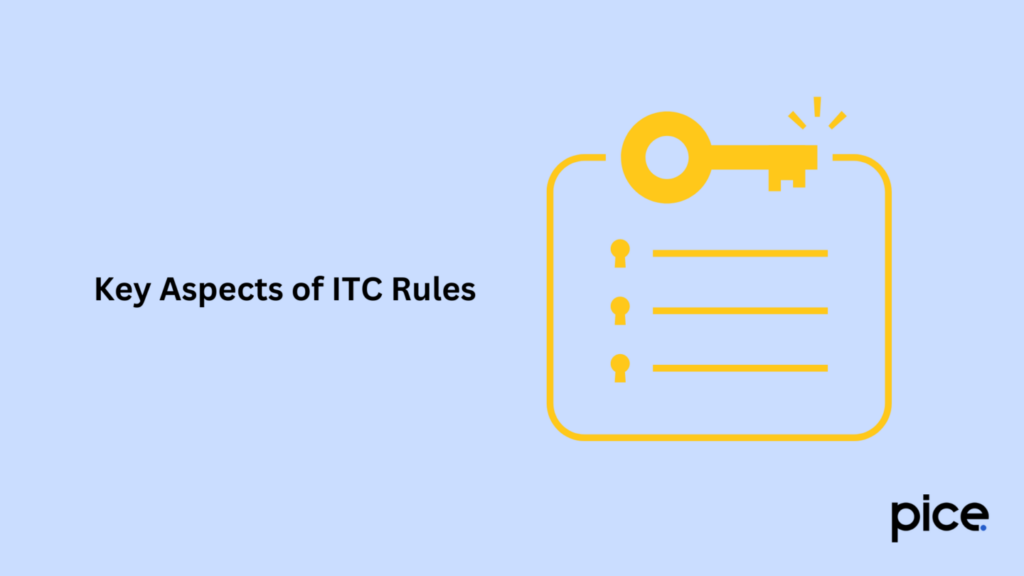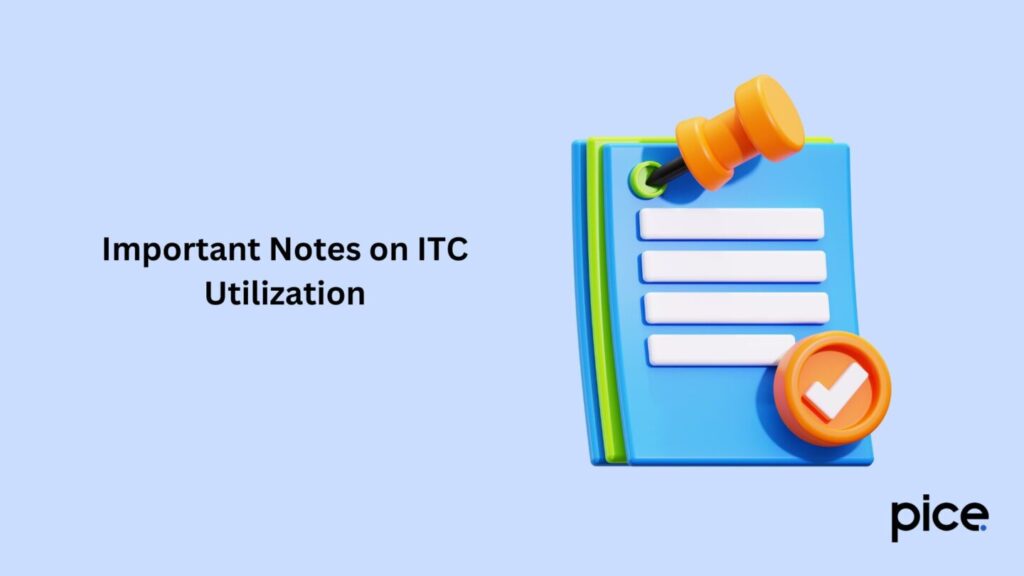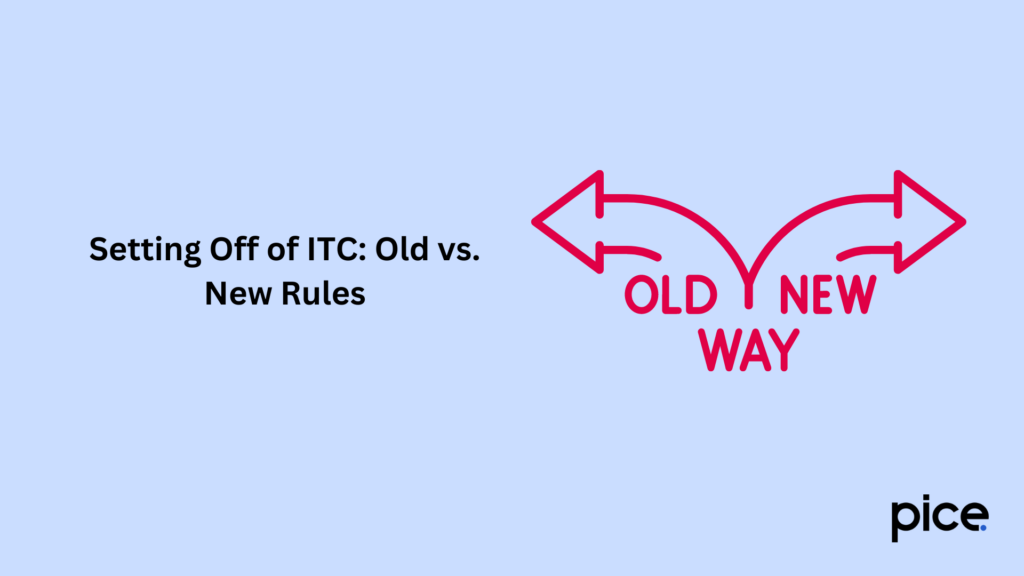Step-by-Step Guide to Input Tax Credit Set Off
- 20 Sep 24
- 12 mins

Step-by-Step Guide to Input Tax Credit Set Off
Key Takeaways
- Flexible ITC Utilization: The new rules allow for more flexible use of IGST credit, enabling businesses to offset liabilities across IGST, CGST, and SGST, thereby optimizing their tax management.
- Reduced Compliance Burden: Amendments in ITC rules simplify the set-off process, easing the compliance burden and enhancing operational efficiency for businesses.
- Enhanced Cash Flow Management: The revised set-off mechanism improves cash flow by reducing the need to dip into the electronic cash ledger, preserving liquidity.
- Simplified Tax Framework: The shift from rigid old rules to a more adaptable ITC set-off system streamlines the GST framework, making it more business-friendly.
- Maximized ITC Benefits: Businesses can now fully leverage their Input Tax Credit (ITC), reducing overall tax liabilities and improving financial health.
Input Tax Credit (ITC) Rules under the Goods and Services Tax (GST) regime are guidelines that dictate how and when a registered person can claim credit for the taxes paid on inputs (goods or services) used in the course of their business.
These rules ensure that businesses are not taxed multiple times for the same supply chain, allowing for a seamless flow of credit throughout the supply chain, thus reducing the overall tax burden.
Key Aspects of ITC Rules:

- Eligibility for ITC:
- Only a registered person under GST can claim ITC.
- ITC can be claimed on goods and services that are used for business purposes.
- ITC is not available for goods and services used for personal purposes or for exempt or non-taxable supplies.
- Conditions for Claiming ITC:
- The person must be in possession of a tax invoice or debit note issued by a registered supplier.
- The goods or services must have been received.
- The supplier must have deposited the tax with the government.
- The person claiming ITC must have furnished the necessary GST returns.
- Blocked Credits:
- Certain inputs are ineligible for ITC, such as:
- Motor vehicles for personal use.
- Goods or services used for personal consumption.
- Membership of clubs, health, and fitness centers.
- Travel benefits extended to employees on vacation (e.g., leave or home travel concession).
- Certain inputs are ineligible for ITC, such as:
- Time Limits for Claiming ITC:
- ITC must be claimed within a specific period, typically before the due date of filing the return for September of the following financial year or the date of filing the annual return, whichever is earlier.
- Reversal of ITC:
- ITC must be reversed in cases where:
- The recipient fails to pay the supplier within 180 days from the date of invoice.
- Inputs or capital goods are used for non-business purposes or making exempt supplies.
- Capital goods on which ITC was claimed are sold.
- ITC must be reversed in cases where:
- Set-off of ITC:
- ITC can be utilized in a specific order to set off against the output tax liability:
- IGST can be set off against IGST, CGST, and SGST in that order.
- CGST can be set off against CGST and IGST.
- SGST can be set off against SGST and IGST.
- ITC can be utilized in a specific order to set off against the output tax liability:
- Documentation and Record-Keeping:
- Accurate records must be maintained, including tax invoices, debit/credit notes, and relevant returns to substantiate the ITC claims.
Importance of ITC Rules:
These rules are fundamental to the GST system as they prevent the cascading effect of taxes (tax on tax) and ensure that businesses can reduce their tax liability by claiming the credits due to them. This mechanism ultimately makes the goods and services more affordable for the end consumer and promotes the smooth functioning of businesses by lowering their overall tax costs.
Types of taxes under GST for utilization of credit
Under the Goods and Services Tax (GST) regime, there are three main types of taxes that businesses must consider when utilizing their Input Tax Credit (ITC). These taxes are critical in the process of set-off, where the ITC is applied against the outward tax liabilities.
Here’s a breakdown of it
1. Integrated GST (IGST)
- Description: IGST is applicable on inter-state supplies of goods and services, as well as imports into India. This tax is levied by the Central Government and is collected when goods or services move across state borders.
- Utilization of ITC:
- IGST credit can be first utilized to pay off the IGST liability.
- If any credit remains, it can be used to offset the Central GST (CGST) liability.
- Lastly, any remaining IGST credit can be utilized against the State GST (SGST) liability.
2. Central GST (CGST)
- Description: CGST is levied on intra-state supplies of goods and services and is collected by the Central Government. This tax applies when transactions occur within a single state.
- Utilization of ITC:
- ITC of CGST can be used to offset the CGST liability first.
- If any CGST credit remains, it can then be used to pay off the IGST liability.
- Note: CGST credit cannot be used to pay off SGST liabilities.
3. State GST (SGST)
- Description: SGST is also levied on intra-state supplies but is collected by the respective State Governments. Like CGST, it applies to transactions within the same state.
- Utilization of ITC:
- SGST credit is first utilized to settle the SGST liability.
- Any remaining SGST credit can then be used to offset the IGST liability.
- SGST credit cannot be used to pay CGST liabilities.
4. Union Territory GST (UTGST)
- Description: UTGST is applicable in Union Territories (such as Delhi, Chandigarh) and is similar to SGST but is levied by the Union Government.
- Utilization of ITC:
- ITC of UTGST can be used to offset UTGST liability first.
- Any remaining credit can be used against IGST liability.
Important Notes on ITC Utilization:

Electronic Credit Ledger: All ITC available to a registered person is recorded in the electronic credit ledger, which is then used to manage the set-off process for these taxes.
Order of Set-off: The utilization of ITC follows a specific order to ensure that tax liabilities are settled systematically. For instance, IGST credit is versatile and can be used across all types of taxes, while CGST and SGST are more restricted in their application.
Understanding the Amendments and Rules for Setting Off Input Tax Credit (ITC) under GST The Goods and Services Tax (GST) framework in India has undergone significant amendments since its implementation, particularly concerning the rules for setting off Input Tax Credit (ITC).
One of the key amendments includes changes to Section 49(5) of the Central Goods and Services Tax (CGST) Act, impacting how businesses can utilize their ITC to pay off GST liabilities.
This blog explains into the nuances of these amendments, the old and new mechanisms for setting off ITC, and the implications of Rule 88A in CGST.
1. CGST (Amendment) Act: Section 49(5) The CGST (Amendment) Act introduced changes to Section 49(5), which governs the manner in which ITC can be utilized to offset GST liabilities. This section outlines the hierarchy and conditions under which ITC from Integrated GST (IGST), Central GST (CGST), and State GST (SGST) can be applied to discharge tax liabilities.
- Key Changes under the Amendment:
- Old Mechanism: Previously, the order of set-off was stringent, with IGST credit required to be utilized first, followed by CGST and SGST in a prescribed manner.
- New Mechanism: The amendment provides more flexibility in utilizing IGST credit, allowing businesses to offset it against any other liability (IGST, CGST, or SGST) as needed.
2. ITC Rules for Setting Off under Old Mechanism
- Before the amendment, the ITC rules required businesses to adhere to a strict order of set-off:
- IGST Credit: Had to be used first to pay IGST liabilities, then CGST, and lastly SGST.
- CGST Credit: Could only be used to set off CGST liabilities, with the remaining credit applied to IGST liabilities.
- SGST Credit: Could only be used to offset SGST liabilities, with any surplus applied to IGST.
3. Introduction of Rule 88A in CGST
The introduction of Rule 88A brought a significant change to the utilization of ITC. This rule specifically addresses the set-off mechanism for IGST credit:
- Flexibility in Utilization: Rule 88A allows IGST credit to be used to pay off any liability (IGST, CGST, or SGST) without adhering to the old order of set-off. This flexibility has eased the burden on businesses and simplified the process of ITC utilization.
4. Maximum ITC Utilization to Pay GST Liability
- One of the most critical questions businesses face is understanding the maximum ITC that can be utilized to pay off GST liabilities. Under the amended rules:
- IGST Credit: Can be fully utilized to discharge IGST, CGST, and SGST liabilities, maximizing the use of available credit.
- CGST and SGST Credits: Must still be utilized within their respective streams, but any remaining credit can now be applied more flexibly under the new rules.
5. Amendments in ITC Rules
- The amendments to ITC rules have focused on simplifying the set-off process and reducing the compliance burden on businesses. Key changes include:
- Relaxation of Set-off Rules: The new rules allow businesses to optimize their credit utilization without being restricted by the stringent order of set-off.
- Enhanced Flexibility: Businesses can now apply IGST credit more freely, reducing the likelihood of credit accumulation in one tax stream while facing liabilities in another.
6. Confusion in Utilization of IGST Credit
- Despite the amendments, some confusion persists regarding the utilization of IGST credit:
- Transitional Issues: Businesses that had accumulated IGST credit under the old mechanism faced challenges in transitioning to the new rules.
- Documentation and Compliance: Proper documentation and adherence to the new rules are crucial to avoid penalties and ensure smooth credit utilization.
7. Setting Off of ITC: Old vs. New Rules

The setting off of Input Tax Credit (ITC) under the Goods and Services Tax (GST) framework has seen significant changes from the old to the new rules, particularly impacting how businesses can utilize their entire input tax credit.
This shift has implications for managing output liability, handling outward supply, and ensuring compliance under different tax schemes, including the composition scheme.
The transition from the old to the new ITC set-off rules represents a significant improvement for businesses in India. By providing greater flexibility in utilizing entire input tax credit, the new rules help businesses manage their capital requirements, improve cash flow, and reduce the burden of business compliances.
The focus on efficient credit utilization ensures that businesses can achieve maximum benefit while remaining compliant with the GST framework, ultimately contributing to a more robust and streamlined tax system.
- Old Rules: Limited flexibility, strict order of set-off, and frequent credit accumulation issues.
- New Rules: Greater flexibility, more efficient credit utilization, and simplified compliance.
8. Effect of New GST Set Off Rules The new GST set-off rules have significantly improved how businesses manage their Input Tax Credit (ITC), including the ITC of SGST, leading to several key benefits:
1. Reduced Compliance Burden The simplified rules reduce the compliance burden by allowing more flexible use of ITC across different tax streams, making it easier for businesses to manage their GST liabilities without excessive administrative work.
2. Improved Cash Flow By enabling efficient ITC utilization, the new rules help businesses preserve liquidity by reducing reliance on the electronic cash ledger for payment of taxes. This optimization of the entire input tax credit helps maintain cash flow for other business needs.
3. Enhanced Business Efficiency The streamlined ITC set-off process aligns better with business operations, supporting a complete supply chain solution and enhancing overall efficiency. This is particularly beneficial for sectors like health services and consumer products.
4. Optimized ITC Utilization Businesses can now better manage their ITC across different types of tax, ensuring maximum use of available credits and reducing overall tax liabilities, thereby gaining the maximum benefit from their ITC.
Conclusion
The evolution of Input Tax Credit (ITC) rules under the Goods and Services Tax (GST) regime, particularly with the amendments in Section 49(5) of the CGST Act and the introduction of Rule 88A, has provided businesses with much-needed flexibility and clarity in managing their tax liabilities.
The shift from the old mechanism, which had a rigid and sometimes cumbersome set-off order, to the more flexible rules under the recent amendments, marks a significant improvement in the GST system.
Businesses can now maximize their ITC utilization by taking advantage of the more lenient rules for setting off IGST, CGST, and SGST credits. The amendments have reduced the compliance burden, enhanced cash flow management, and allowed for more efficient operations by simplifying the ITC set-off process.
💡If you want to pay your GST with Credit Card, then download Pice Business Payment App. Pice is the one stop app for paying all your business expenses.
 By
By 
















